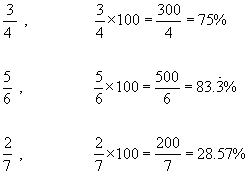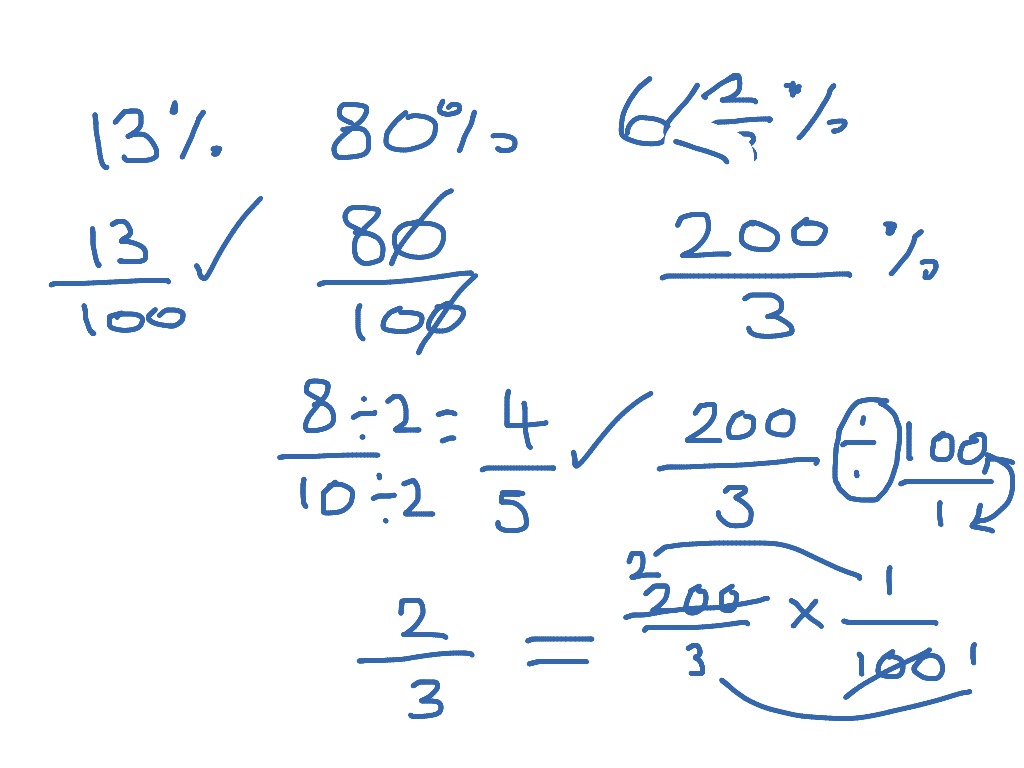
When multiplying percents by another number, the operation creates a new value equal to the given percent of the original number.If the percentage amount is under 100, the product will be less than the original number. Unless there is a reason to use one over the other, it is a personal preference and you may choose either.īy itself, a percent is just a representation of a part of a whole.

In most cases, unless the direction specify, it doesn't matter whether you convert the percentages into decimals or fractions. You cannot calculate a multiplication math problem correctly without first making this conversion. When you have a math problem that requires you to multiply one or more percentages, you must first convert the percentage into a decimal or fraction.
FRACTIONS TO PERCENTAGES SIMPLIFIED HOW TO
Related: Basic Math Skills: Definitions, Examples and How To Improve Them Multiplying with percentages Consumers encounter percents every time they go shopping, since the store applies sales tax to their bill as a percentage. For example, in the finance industry, you use percents to find the rate of return, market shares, interest rates and growth trends. Many industries use percentages on a daily basis. Percents are a common mathematical term and used frequently in basic math, statistics, probability and other mathematical calculations. Sometimes you'll see it referred to as " per one hundred," " for every 100" or " out of 100." A percentage is often used to define a fractional part of a whole. What is a percentage?Ī percentage, or percent, is a proportion between two numbers expressed in hundredths. In this article, we’ll discuss percentages, including how to multiply them, how to convert percentages into decimals and fractions and how to multiply a percent by another percent, a whole number, a decimal and a fraction. Knowing how to multiply percentages is a useful skill for personal use and work, especially if you need to solve percentage problems without using a calculator. Common examples of when you may need to multiply percentages are for calculating sales tax or discounts, leaving tips, earning a commission or determining interest. Calculating percentages can help you in your daily life.

In this case, we can simplify the fraction down to 1/20. 63/1 will become 63/100 after we multiply the top and bottom by 100. This will give you a fraction.įor example.

Then multiply them both by ten as many times as you need to get whole numbers on top and bottom. Create a fraction with the decimal as the numerator and "1" as the denominator. To convert a decimal into a fraction, you just have to do the same process in reverse. You show that a decimal repeats by drawing a line over the last two numbers. In some cases, there is no easy way to divide. The result won't always have a simple answer. To turn a fraction into a decimal, divide the numerator by the denominator. Converting fractions into decimal numbersĬonverting fractions to decimals is simple once you know your division. The important thing to know is that, most of the time, you only want to write out to the second decimal place (or the "hundredths" place). That's a bit of an involved process, so we won't go over that step by step here. The best way to calculate decimals is using long division. To keep things simple, we mark off the start of these decimal numbers with a decimal point or period. The number of places we go beyond 1 are called decimal places.

With a decimal, though, the numbers go after the 1s place instead of before. It's called a "decimal" because it's done in groups of ten ("dec-" in Latin), like normal numbers. How to handle decimalsĪ decimal is another way of showing a partial number. In general you want to divide down to the smallest numbers you can this is called simplifying fractions. The way to get equivalent fractions is the multiply or divide the top and bottom numbers by the same number. Sometimes fractions can be written differently but have the same value. Improper fractions can also be written out as a mix of a whole number and a fractions. If the number on top is larger we call it an improper fraction. The number on bottom is called the denominator this is how many of those parts make one whole (Two thirds).īecause a fraction means a "part" of something, we call fractions "proper" if the number on top is smaller than the number on bottom (this means that it is less than 1). The number on top is called the numerator this is the number of parts we have ( Two thirds). To use fractions, we need to figure out what number goes on top, and what goes on bottom. "Two thirds" would be written out as 1/3. A fraction usually means a number of equal parts like "one half" and "two thirds." This is written as one whole number over another whole number. How to tackle fractionsįractions are a common way of writing out partial numbers. Fractions and decimals are two common ways to write out partial numbers.


 0 kommentar(er)
0 kommentar(er)
